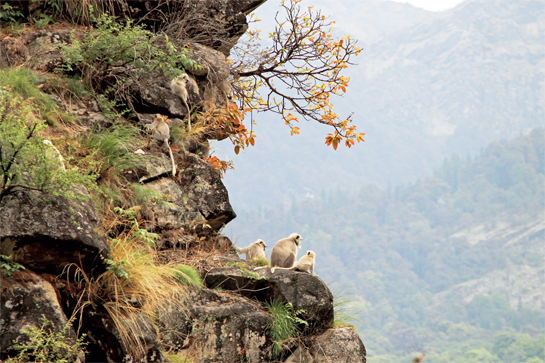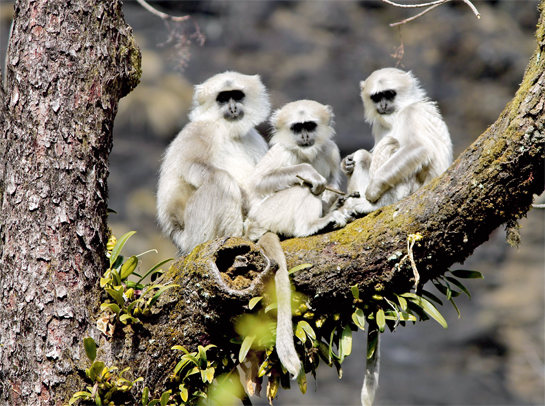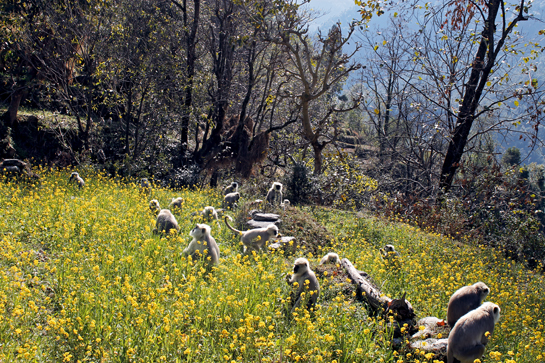From The Hills Of The Himalayan Langur
First published in Sanctuary Asia,
Vol. 35
No. 7,
July 2015
By Himani Nautiyal
“Danda ma gham achegi, tese pela siyodu chalijiyan" (go to bed, before the suns rays leave the highest peak) - is an old Garhwali saying from the near mystical hamlets nestled in the folds of the great Himalaya that truly reflects the danger of living in big cat country as told in Jim Corbetts Man-eaters of Rudraprayag.
My Teacher is the Himalaya
Born in one such little village of Rudraprayag, surrounded by forests, I grew up in awe of nature - my childhood laid the foundation stone for my attachment to the wild. And my childhood fear of the unknown was transformed into curiosity for the new. It is the Himalaya that gifted me my interest in wildlife. To pursue this passion, I took up Forestry for my B.Sc. degree and was gradually drawn to animal behaviour, especially that of primates.
Drawn by fond memories of my childhood, I always wanted to return to work in a remote village of the Himalaya. And there could be no better option than Mandal, a sleepy little village at the base of a steep valley, leading towards the Rudranath peak of the Garhwal Himalaya. It is here, in Garhwal in 1974, that the local women blessed the world with the ‘Chipko Andolan, the non-violent resistance against the timber mafia, through the act of hugging trees. Steeped in history and representing one of the many villages that skirt the fringes of the Kedarnath Wildlife Sanctuary, Mandal proved to be an ideal base for my field work.

Photo: Himani Nautiyal.
A Golden Opportunity
An Indian Academy of Science fellowship gave me the golden opportunity to study central Himalayan langurs and to understand the interface between them and humans, under the guidance of the highly-respected primatologist, Prof. Anindya Sinha. I started my research in langur behaviour in two different habitats, one inside the Kedarnath Wildlife Sanctuary and the other close to Mandal village.
The central Himalayan langur Semnopithecus schistaceus is among the least-studied primates in the world and there is very little knowledge about their behaviour and ecology. My preliminary study lasted just two months, which was not nearly enough time to start to unravel the mysteries these primates hold. I yearned to learn more about their behaviour across the broad altitudinal range of the Himalaya. Opportunity smiled on me in the form of a grant from the Rufford Small Grant Foundation and I got to study, in depth, the central Himalayan langur, the only primate species found up to an elevation of 4,500 m. in the Himalaya.
Survival
My goals for my current study are to find the different strategies these langurs use across their wide altitudinal range (1,500 to 4,500 m.) to survive in these harsh environmental conditions. The Himalayan climate is altering rapidly due to the effects of global warming and it is important to learn how these primates adapt themselves to unpredictable weather over the long-term in order to know how to conserve this species and its habitat.
To make matters more complex, the people living in these remote Himalayan villages, like the one where I grew up, are facing problems of crop raiding by langurs. Because these villages are located on the periphery of the sanctuary, human-wildlife conflict is quite high. The Himalayan black bear, wild pig, rhesus macaque and central Himalayan langur are the species primarily responsible for crop damage. Villagers are also losing their cattle, sheep and goats to leopard predation.
Though agriculture is the primary form of livelihood in the region, farming alone is not a sustainable source of income, so it is supplemented by the sale of milk. Due to the need for fuel and fodder, women, from the ages of eight to 80, regularly venture into the furthest reaches of the forest. Conflict between humans and bears is increasing alarmingly - and lives are being lost in the form of people, livestock and wildlife in the bargain. To better understand langur and human interaction and to mitigate these problems, I am interviewing local people in search of new ways to deal with this escalating issue.

Photo: Abhijit Dey.
Beautiful Bonds
If you ask me, what is the most beautiful species of the Himalaya - I will unflinchingly nominate the central Himalayan langur.
Theirs is a multi-male dominated society. Each troop has five to six adult males who share responsibilities for the welfare of the troop. Females usually spend more time with other closely related adult females, sub-adults and juveniles and sub-grouping is a common feature.
Infants depend on their mothers up to the age of one-and-half years and watching them in their growing months is riveting. Just like children in kindergarten, they spend most of the time in a play group. The fascinating part about their behaviour is the selection of the same play sites. Inside the troops territory at each feeding site, the infants have almost two or three designated playgrounds. But unlike human children, langur young are disciplined and systematic. They follow rules even while playing. Swinging and jumping are very prominent play behaviour. They start by running up onto a large branch of their favourite tree that generally makes a certain angle with the slope. They then move out and swing on a smaller branch of a certain height and jump to flatter ground, before starting all over again. Another striking behaviour is their tendency to form a queue. Sometimes they are joined by juveniles and sub-adults. Their antics are hysterical, and Im constantly entertained in their presence.
Infants depend heavily on parental care in the early stages of their lives. Mothers make every effort to care for their newborns during the first five to six days. Caring deeply for the infant, the mother spends very little time feeding or grooming herself. All adult females in the same closely associated family sub-group help the mother in child rearing. For example, they will carry the newborn when the mother goes off to feed or to spend some time grooming with the others. Adult males are especially protective of adult females with young. In order to survive in this environment, the group members must look out for each other.

Photo: Himani Nautiyal.
Uncertain but Hopeful
Though, while writing this article, I am miles away from my field site, embroiled in paper work; part of me still resides there, watching over the gambolling infants! With almost three newborns in each troop that I am studying, growing up in parental care, I am hopeful that they will beat all odds, challenge all uncertainties and will survive the ever-burgeoning anthropogenic pressure. I am hopeful that human greed wont consume their few needs. I worry for my troops, but I always remember the words of Dr. George B. Schaller, “I am a conservationist. I cannot afford to lose hope."
Interested in the behavioural ecology of primates and human-non human primate interconnections in the higher Himalayan regions, Himani Nautiyal is pursuing a Masters in Wildlife Biology from A.V.C. College, Tamil Nadu.




